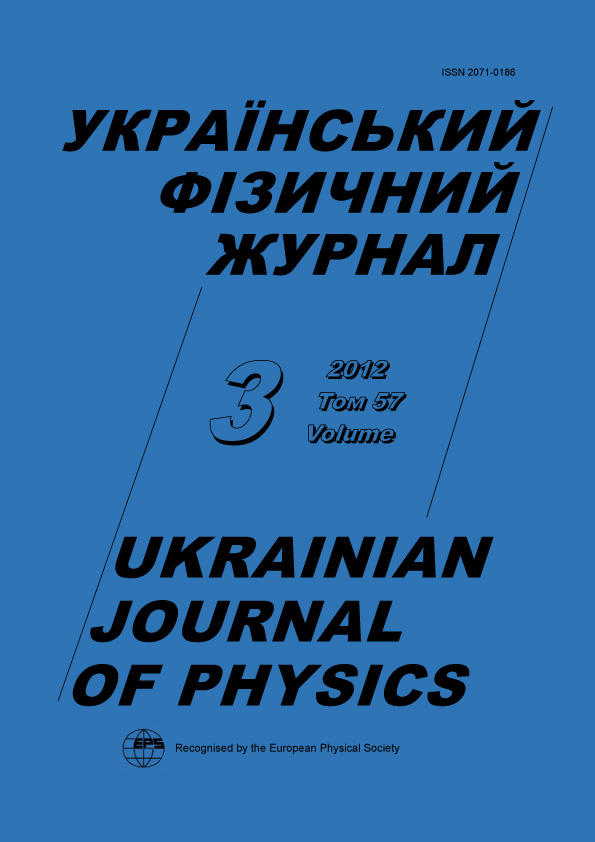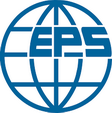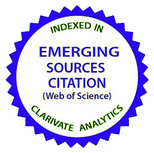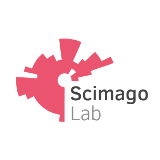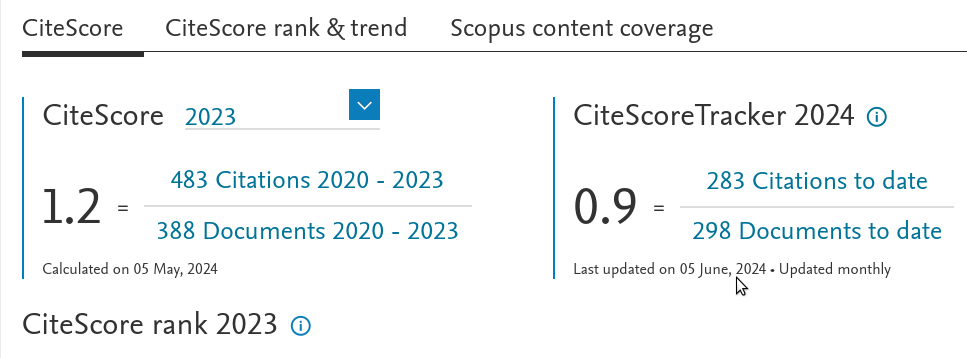Interaction between an Isotropic Nanoparticle and Drifting Electrons in a Quantum Well
DOI:
https://doi.org/10.15407/ujpe57.3.367Keywords:
-Abstract
A hybrid system composed of an isotropic nanoparticle and a semiconductor heterostructure with a quantum well has been considered. The nanoparticle is supposed to be polarizable in an external electric field. A theoretical model of the hybrid system is substantiated and formulated. Exact solutions of the model equations are obtained. The frequencies of charge oscillations in the hybrid system and their damping owing to the dipole--plasmon interaction are found, the damping mechanism being similar to that of Landau damping. The space-time behavior of concentration perturbations in the two-dimensional electron gas is analyzed, and the polarization oscillations of a nanoparticle are studied. The induced polarization of a nanoparticle at nonzero electron drift velocities is found to have a complicated dynamics. In particular, the polarization vector circulates along elliptic trajectories for two of three frequency
dispersion branches. If the electric current flows through the quantum well due to an applied electric field, the damping of oscillations in the hybrid system is replaced by their growth in time, which corresponds to the electric instability of the system. New phenomena in hybrid systems can be used to excite the emission of nanoparticles by an electric current and to electrically stimulate the emission in the terahertz spectral range.
References
P. Bakshi and K. Kempa, Superlatt. Microstruct. 17, 363 (1995).
https://doi.org/10.1006/spmi.1995.1064
S.A. Mikhailov, Recent Res. Devel. Appl. Phys. 2, 65 (1999).
B.Y.K. Hu and J.W. Wilkins, Phys. Rev. B 41, 10706 (1990).
https://doi.org/10.1103/PhysRevB.41.10706
Z.S. Gribnikov, N.Z. Vagidov, and V.V. Mitin, J. Appl. Phys. 88, 6736 (2000).
https://doi.org/10.1063/1.1322383
K. Kempa, P. Bakshi, and E. Gornik, Phys. Rev. B 54, 8231 (1996).
https://doi.org/10.1103/PhysRevB.54.8231
M. Dyakonov and M.S. Shur, Phys. Rev. Lett. 71, 2465 (1993)
https://doi.org/10.1103/PhysRevLett.71.2465
Appl. Phys. Lett. 87, 111501 (2005).
https://doi.org/10.1063/1.2042547
W. Knap, J. Lusakowski, T. Parenty, S. Bollaert, A. Cappy, V.V. Popov, and M.S. Shur, Appl. Phys. Lett. 84, 2331 (2004).
https://doi.org/10.1063/1.1689401
J. Lusakowski, W. Knap, N. Dyakonova, L. Varani, J. Mateos, T. Gonzalez, Y. Roelens, S. Bollaert, and A. Cappy, J. Appl. Phys. 97, 064307 (2005); N. Dyakonova, A. El Fatimy, J. Lusakowski, W. Knap, M.I. Dyakonov, M.-A. Poisson, E. Morvan, S. Bollaert, A. Shchepetov, Y. Roelens, Ch. Gaquiere, D. Theron, and A. Cappy, Appl. Phys. Lett.
https://doi.org/10.1063/1.1861140
, 141906 (2006).
T. Otsuji, Y.M. Meziani, T. Nishimura, T. Suemitsu, W. Knap, E. Sano, T. Asano and V.V. Popov, J. Phys.: Condens. Matter 20, 384206 (2008).
https://doi.org/10.1088/0953-8984/20/38/384206
T. Demel, D. Heitman et al., Phys. Rev. Lett. 64, 788 (1990).
https://doi.org/10.1103/PhysRevLett.64.788
Ch. Sikorski and U. Merkt, Phys. Rev. Lett. 62, 2164 (1989)
https://doi.org/10.1103/PhysRevLett.62.2164
B. Meurer, D. Heitmann, and K. Ploog, Phys. Rev. Lett. 68, 1371 (1992)
https://doi.org/10.1103/PhysRevLett.68.1371
D. Heitmann and J.P. Kotthaus, Phys. Today, 48, 56 (1993).
https://doi.org/10.1063/1.881355
S.M. Reimann and M. Manninen, Rev. Mod. Phys. 74, 1283 (2002).
https://doi.org/10.1103/RevModPhys.74.1283
C.P. Garcia, S. Kalliakos, V. Pellegrini, A. Pinczuk, B.S. Dennis, L.N. Pfeiffer, and K.W. West, Appl. Phys. Lett. 88, 113105 (2006).
https://doi.org/10.1063/1.2185447
B. Yu, F. Zeng et al., Biophys. J. 86, 1649 (2004).
https://doi.org/10.1016/S0006-3495(04)74233-2
V.N. Maistrenko, S.V. Sapernikova et al., J. Analyt. Chem. 55, 586 (2000).
https://doi.org/10.1007/BF02757819
R. Balu, H. Zhang et al., Biophys. J. 94, 3217 (2008).
https://doi.org/10.1529/biophysj.107.105163
J. Burghoon, T.O. Klaassen, and W.T. Wenchebach, Semicond. Sci. Technol. 9, 30 (1994).
https://doi.org/10.1088/0268-1242/9/1/006
A.J. Kalkman, H.P.M. Pellemans, T.O. Klaassen, and W.T. Wencheback, Int. J. Infrared Millim. Waves 17, 569 (1996).
https://doi.org/10.1007/BF02088030
D.G. Allen, M.S. Sherwin, and C.R. Stanley, Phys. Rev. B 72, 035302 (2005).
https://doi.org/10.1103/PhysRevB.72.035302
S.M. Kukhtaruk, Ukr. J. Phys. 55, 8, 916 (2010).
A.S. Davydov, Quantum Mechanics (Pergamon Press, New York, 1976).
E.M. Lifshitz and L.P. Pitaevskii, Physical Kinetics (Pergamon Press, New York, 1981).
V.V. Mitin, V.A. Kochelap, and M.A. Stroscio, Quantum Heterostructures (Cambridge Univ. Press, New York, 1999).
F. Kuchar, G. Bauer, and H. Hillbrand, Phys. Status Solidi A 17, 491 (1973).
https://doi.org/10.1002/pssa.2210170213
A. Krotkus and Z. Dobrovolskis, Electrical Conductivity of Narrow-Gap Semiconductors (Mokslas, Vilnius, 1988) (in Russian).
W.T. Masselink, Semicond. Sci. Technol. 4, 503 (1989).
https://doi.org/10.1088/0268-1242/4/7/001
L.D. Landau and E.M. Lifshitz, The Classical Theory of Fields (Pergamon Press, Oxford, 1983).
M.A. Nielsen and I.L. Chuang, Quantum Computation and Quantum Information (Cambridge Univ. Press, Cambridge, 2000).
Downloads
Published
How to Cite
Issue
Section
License
Copyright Agreement
License to Publish the Paper
Kyiv, Ukraine
The corresponding author and the co-authors (hereon referred to as the Author(s)) of the paper being submitted to the Ukrainian Journal of Physics (hereon referred to as the Paper) from one side and the Bogolyubov Institute for Theoretical Physics, National Academy of Sciences of Ukraine, represented by its Director (hereon referred to as the Publisher) from the other side have come to the following Agreement:
1. Subject of the Agreement.
The Author(s) grant(s) the Publisher the free non-exclusive right to use the Paper (of scientific, technical, or any other content) according to the terms and conditions defined by this Agreement.
2. The ways of using the Paper.
2.1. The Author(s) grant(s) the Publisher the right to use the Paper as follows.
2.1.1. To publish the Paper in the Ukrainian Journal of Physics (hereon referred to as the Journal) in original language and translated into English (the copy of the Paper approved by the Author(s) and the Publisher and accepted for publication is a constitutive part of this License Agreement).
2.1.2. To edit, adapt, and correct the Paper by approval of the Author(s).
2.1.3. To translate the Paper in the case when the Paper is written in a language different from that adopted in the Journal.
2.2. If the Author(s) has(ve) an intent to use the Paper in any other way, e.g., to publish the translated version of the Paper (except for the case defined by Section 2.1.3 of this Agreement), to post the full Paper or any its part on the web, to publish the Paper in any other editions, to include the Paper or any its part in other collections, anthologies, encyclopaedias, etc., the Author(s) should get a written permission from the Publisher.
3. License territory.
The Author(s) grant(s) the Publisher the right to use the Paper as regulated by sections 2.1.1–2.1.3 of this Agreement on the territory of Ukraine and to distribute the Paper as indispensable part of the Journal on the territory of Ukraine and other countries by means of subscription, sales, and free transfer to a third party.
4. Duration.
4.1. This Agreement is valid starting from the date of signature and acts for the entire period of the existence of the Journal.
5. Loyalty.
5.1. The Author(s) warrant(s) the Publisher that:
– he/she is the true author (co-author) of the Paper;
– copyright on the Paper was not transferred to any other party;
– the Paper has never been published before and will not be published in any other media before it is published by the Publisher (see also section 2.2);
– the Author(s) do(es) not violate any intellectual property right of other parties. If the Paper includes some materials of other parties, except for citations whose length is regulated by the scientific, informational, or critical character of the Paper, the use of such materials is in compliance with the regulations of the international law and the law of Ukraine.
6. Requisites and signatures of the Parties.
Publisher: Bogolyubov Institute for Theoretical Physics, National Academy of Sciences of Ukraine.
Address: Ukraine, Kyiv, Metrolohichna Str. 14-b.
Author: Electronic signature on behalf and with endorsement of all co-authors.

